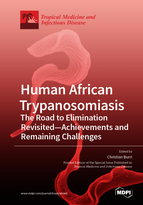Human African Trypanosomiasis (Sleeping Sickness): The Road to Elimination Revisited—Achievements and Remaining Challenges
A special issue of Tropical Medicine and Infectious Disease (ISSN 2414-6366). This special issue belongs to the section "Neglected and Emerging Tropical Diseases".
Deadline for manuscript submissions: closed (30 November 2019) | Viewed by 72446
Special Issue Editor
Interests: sleeping sickness (human African trypanosomiasis); drug and vaccine development against neglected tropical diseases; clinical trials in low resource settings; implementation research; public health
Special Issue Information
Dear Colleagues,
The positive opinion expressed on 16 November 2018 by the European Medicines Agency on the use of the oral drug fexinidazole against human African trypanosomiasis (HAT) caused by T.b. gambiense may be considered a milestone in the treatment of the disease and contributes an essential component towards its elimination. With tremendous efforts, the treatment could be improved, with respect to the past almost 30 years, from a 35-days treatment with the injectable organoarsenic drug melarsoprol with a drug-attributable fatality rate of 5% down to the 10 days oral fexinidazole treatment with a mortality rate of 0.5%. However, this is only one of the many pieces we need to combine in the puzzle of a successful battle against this disease. While the number of T.b. gambiense HAT cases is decreasing, and the dreadful melarsoprol has been replaced by the new treatment, many other issues still need to be addressed to reach the goal of sustainable disease elimination by 2030. Case identification and diagnosis remain complicated and require substantial screening efforts and specific skills (such as case confirmation by microscopy). Contrary to an old dogma, recent evidence shows that not all patients die from the disease, but some may remain infective over many years; in addition, the relevance and nature of the animal reservoir for T.b. gambiense HAT are still not conclusively resolved. Enough questions for a disease marked for elimination, but, eventually, the human factor will be decisive in the “end game”, where decentralized disease recognition and management in lower level health structures and communities, disease awareness and stigma, unrelenting disease surveillance in known foci, as well as oblivion in areas where HAT has not occurred may play a determining role but have not been studied in depth yet. All these unresolved questions gain a significant importance in the light of the known threat of recurrence at large scale of this disease.
As if HAT caused by T.b. gambiense were not a very neglected disease and all this not enough for a considerable challenge, the other form of the disease caused by T.b. rhodesiense is an even more neglected and much more fulminant illness targeted for elimination, with a clear zoonotic reservoir and still only treatable with the old drugs pentamidine and suramin in the first stage and melarsoprol in the late stage, with stage determination requiring a lumbar puncture.
Given where we stand regarding both diseases, it seems now a close-to-perfect time for an overview, status check, and collection of new ideas and innovative approaches to reach the goal of elimination of these debilitating diseases and prepare against their recurrence.
Prof. Christian Burri
Guest Editor
Manuscript Submission Information
Manuscripts should be submitted online at www.mdpi.com by registering and logging in to this website. Once you are registered, click here to go to the submission form. Manuscripts can be submitted until the deadline. All submissions that pass pre-check are peer-reviewed. Accepted papers will be published continuously in the journal (as soon as accepted) and will be listed together on the special issue website. Research articles, review articles as well as short communications are invited. For planned papers, a title and short abstract (about 100 words) can be sent to the Editorial Office for announcement on this website.
Submitted manuscripts should not have been published previously, nor be under consideration for publication elsewhere (except conference proceedings papers). All manuscripts are thoroughly refereed through a single-blind peer-review process. A guide for authors and other relevant information for submission of manuscripts is available on the Instructions for Authors page. Tropical Medicine and Infectious Disease is an international peer-reviewed open access monthly journal published by MDPI.
Please visit the Instructions for Authors page before submitting a manuscript. The Article Processing Charge (APC) for publication in this open access journal is 2700 CHF (Swiss Francs). Submitted papers should be well formatted and use good English. Authors may use MDPI's English editing service prior to publication or during author revisions.
Keywords
- sleeping sickness
- human African trypanosomiasis
- T. b. gambiense
- g-HAT
- T. b. rhodesiense
- r-HAT
- elimination
- neglected tropical diseases







